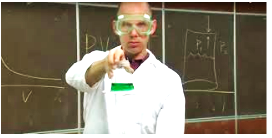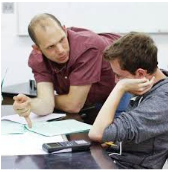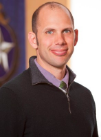
Podcast: Play in new window | Download
Subscribe: Spotify | TuneIn | RSS
Ramsey Musallam is a secondary science instructor at Sonoma Academy in Santa Rosa, California. He runs invention workshops for elementary and middle school students and delivers keynotes, webinars and facilitates workshops for teachers nationally and internationally with a focus on using technology as a strategic classroom partner in designing learning environments grounded in inquiry fueled by student curiosity. Ramsey is also the author of Spark Learning and a TedTalk speaker as part of the first TedTalks Education.

Your background (where you grew up)
I grew up in Sacramento, California. I wasn’t much of a student. I was a competitive athlete. That’s how I got into college with a basketball scholarship at Cal Poly and then transferred to UC Davis. That’s where I fell in love with school and loved learning. My journey as a science teacher started there. I didn’t get into medical school and I was left with a lot of science knowledge to that point. I got a job substitute teaching high school science at Sacred Heart Cathedral Prep in San Francisco. I fell in love with the vocation and went back to get my teaching credential, my masters, and my Ph.D. That’s really how my journey as a teacher began.
What it was like when you were a student
I’m a typical child of the Baby Boomers where my parents sent me to kindergarten just when I turned four so I could walk with our neighbor to school or out of some archaic reason. I fell drastically behind emotionally and mentally academically. By the time I got to the 6th grade, I was just a hot mess. I ended up going to 6th grade twice and had a chance to transfer schools to sort of reinvent myself. Even with that, I was behind academically and only I knew that basketball was what was going to get me into college. Academically, I always struggled as a slow reader and not a great test taker. What I figured out was how to translate some of those skills that I learned in sports to academic learning. I was a very hard worker around that.
Still to this day, I’m not a good test taker and have a lot of intellectual insecurity even with a Ph.D. teaching advanced placement courses and graduate school now. It’s easy to say “that helps me relate to kids or helps me explain concepts in a way people can understand” but those are clichés. This is part of my story and something I struggle with. It does help me connect to struggling students and, at times, inhibits me from connecting to students who don’t struggle. It’s just part of who I am and my journey to get there. That’s why I see teaching as more of a vocation than an intellectual endeavor. It is more of a craft.
“When you see teaching as a craft, then you see it as
something that transcends intellectual capacity.”

[This is Barbara. Make sure you listen to what Ramsey mentions as the Impostor Complex and teachers coming across as mythical creatures. 8:33 – 9:45]
Your family and what happened in 2008 that changed you
In 2008, they found an aneurysm in my aorta in my heart. It was a random find that was a very existential sort of life-changing thing where I had to face a complex open-heart surgery. Right at the exact same time, I was finishing up my graduate work at school. I was in the middle of reflecting on myself as a teacher and at the same time had o reflect on myself as a human. When we first found out about my condition, my wife was pregnant with our first daughter. When I had the surgery, she was pregnant with our second daughter.
I have four children and all of them mirror the same pathway I had as a kid and struggle in their own ways which is really interesting to see. I have a 10-year-old daughter in 5th grade and is very involved in theater. My 8-year-old daughter who is in second grade has a formal IEP and gets pulled out 50% of the time. It is pretty amazing to see the support she is getting in a public school if you go through the proper channels with a legal document. She has benchmarks she has to reach by law. Because of that, there is built-in accountability with a natural backwards design towards what they are going to do to get her there. My two twin boys who are four and a half are in preschool so it is still to be determined if they will have similar struggles or not.
Journey as a science instructor and where you are now
I went into science education because that was my expertise and the only content I had after college. That was my expertise and I couldn’t use it to become a doctor. The curiosity piece is a tumultuous relationship with teaching.
In 2004, the EdTech scene exploded. It went to Smartboards, then Google docs and video played a central role. In 2006, when I was doing my graduate work, I stumbled across the idea of integrating technology in the classroom. I started doing research around the flipped classroom that was published in my dissertation. The consulting door opened up to me at that point because I was doing some actual quantitative research on that. That journey into the flipped classroom world allowed me to teach full-time and be able to consult and stay in the classroom. Because I got to stay in the classroom, I got to continuously evaluate whether or not this thing I was doing in research and in practice was having any sort of effectiveness. I realized that I felt that my students weren’t learning anymore and actually were demotivated.
That forced me to face what am I doing wrong and what am I missing. That led to the whole journey of how to appropriately position direct instruction in the context of the learning cycle, the role of engagement with cognition, and where video can play a part in learning. I realized that for high school students wanting to watch a video is more important than how or where they watch it. I don’t believe a flipped classroom is any sort of paradigm shift. It is a technique to be used strategically. It is not a pedagogy. That was controversial so it led to my Ted Talk on the first Ted Talks Education.
TED Talk: 3 Rules to Spark Learning https://www.ted.com/talks/ramsey_musallam_3_rules_to_spark_learning/up-next?language=en
How Do You Motivate Students to Want to Learn?
Motivation and engagement are symptoms of curiosity. Curiosity isn’t just wanting to know something. Curiosity is the awareness of an information gap. When people are aware that an information gap exists in a way that is not too easy or too hard to fill, you are actually finding this sweet spot that gives them a little but not enough. You can make people feel dissonance in their cognition. Imagine people telling you a riddle that is on the tip of your tongue. Motivation and engagement spur from that, because they motivate and engage the learner to fill the information gap.
The big shift is not thinking about engagement and motivation as being related to teacher personality, classroom environment, or the type of activity you are doing. It’s related to how salient information is for the learner. When they realize there is a gap, then you have them right there and they will do anything for you because they want to fill the gap. Now, I’m trying to figure out what I do before I teach the content. How do I put them in a position where they are able to know enough but not the whole story so that they tunnel themselves and have to go to me for my info to complete this picture? That’s when I tell them the info. Maybe I’ll do that in a video or maybe I won’t, but that’s the difference. It’s delayed direct instruction. It’s modeling the hero’s journey in the lesson planning content where the mentor is always in response to struggle. The mentor is not the one who creates the struggle.
[This is Barbara: I decided it is best for you to listen to Ramsey from 21:00 on about how to spark learning so your learners can harness the power of curiosity.]
Sharing Ramsey’s Book: Spark Learning (3 Rules to Spark Learning)
“As a full-time high school science teacher and department chairperson, I am passionate about building and sharing innovative learning environments grounded in inquiry and guided by curiosity. Student questions can be windows into dynamic and tailored blended instruction, but not the other way around.”
****
 Ramsey Musallam is a secondary science instructor at Sonoma Academy in Santa Rosa, California. Ramsey has also has served as an adjunct professor of education at the University of San Francisco and Touro University in the San Francisco Bay Area. Prior to his role as a science instructor at Sonoma Academy, Ramsey served as a Science Instructor and Director of Inquiry and Innovation at Sacred Heart Cathedral in downtown San Francisco for 15 years. In addition to his role as a science teacher, Ramsey runs invention workshops for elementary and middle school students in the greater Bay Area.
Ramsey Musallam is a secondary science instructor at Sonoma Academy in Santa Rosa, California. Ramsey has also has served as an adjunct professor of education at the University of San Francisco and Touro University in the San Francisco Bay Area. Prior to his role as a science instructor at Sonoma Academy, Ramsey served as a Science Instructor and Director of Inquiry and Innovation at Sacred Heart Cathedral in downtown San Francisco for 15 years. In addition to his role as a science teacher, Ramsey runs invention workshops for elementary and middle school students in the greater Bay Area.
Ramsey delivers keynotes, webinars and facilitates workshops for teachers nationally and internationally with a focus on using technology as a strategic classroom partner in designing learning environments grounded in inquiry fueled by student curiosity. Additionally, Ramsey is the host of the Infinite Thinking Machine, an internet TV show dedicated to sharing innovative ideas for teachers and students. Ramsey’s TED Talk “3 Rules to Spark Learning” is widely popular with classroom teachers, and was the lead talk on Ted’s first-ever PBS TV premiere, “TED Talks Education.”
Upon graduating from the University of California Davis with a BS in Molecular and Cellular Biology, Ramsey went on to obtain an MA and an Ed.D in Education from the University of San Francisco. Since graduating, Ramsey’s research interests have shifted from using Multimedia to manage student Cognitive Load, to a focus on harnessing Multimedia as a tool in cultivating student curiosity, inquiry, and motivation.
Ramsey Musallam contact info
Twitter: @ramusallam
Blog: https://www.cyclesoflearning.com
*****
For all of the Rethinking Learning podcasts with Barbara Bray, click on the podcast tab at the top, the logo below, or go to https://barbarabray.net/podcasts/
Go to this page for more information about Barbara’s new book, Define Your WHY.







[…] was honored to join Barbara Bray on episode #89 of her podcast RethinkingLearning. Click here to listen to the the entire episode where Barbara and I take a deep dive into the pedagogy and […]